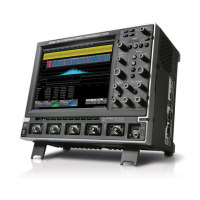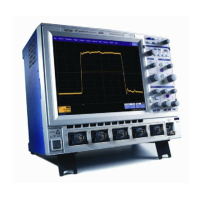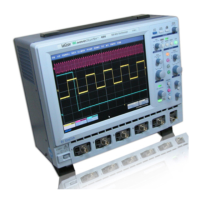364 WM-OM-E Rev I
DDA REFERENCE INFORMATION
Channel Analysis Concepts
The purpose of Channel Analysis is to find signal quality problems in the head signal. Thus both
methods used by the DDA --- Channel Emulation and Analog Compare --- require that you first
specify the DDA channel or memory on which the head signal is to be carried.
The instrument utilizes the head signal and, optionally, the Read Gate and the Analyze Region
cursors to determine which part of the head signal will be analyzed. What follows is an explanation
of how the instrument does this and the manner in which it processes the head signal.
The following figure shows the fields of the head signal and their relationship to Read Gate.
Head Signal Fields and Read Gate
In a normally operating disk drive, every time Read Gate goes true (at the beginning of every
segment to be read) there must be a repetitive signal called the VCO Synch (voltage-controlled
oscillator). It is needed to adjust the phase of the PLL (phase locked loop), which generates the
sampling clock, and to adjust the AGC (automatic gain control).
The DDA will try to identify the VCO Synch signal in a similar fashion in order to perform channel
emulation. In order to identify VCO Synch, you will need to provide a Read Gate signal or to set the
Analyze Region cursors (see Selecting the Waveform Section to be Analyzed). After the DDA
analyzes the VCO Synch signal, it is ready to analyze the data field for problems. Since the data
field generally does not start immediately after the end of the VCO Synch field, the DDA needs to
know where the data field starts. You must specify the number of bytes between the VCO Synch
field and the data field. The DDA can then determine the location of the first byte of data.
If the channel analysis method selected is Channel Emulation, the DDA will perform PRML
channel emulation to determine the location of problems in the data field. Often, there is a delay
between the end of valid data and the disabling of the Read Gate. It is generally not meaningful to
analyze this area of a sector for problems. In order to avoid analyzing this area, you can specify the
number of PRML samples between the end of valid data and Read Gate being disabled in the
Ignore Last Samples data entry field in the "Channel Setup" dialog.
Using the DDA's Equalization Filter
Disk drives generally have filters to remove noise and to shape the head signal. Without these
filters, data would not be properly recovered. The DDA provides a similar filter capability. The
equalization filter available in the instrument’s channel emulation can be used with all the channel
analysis methods to clean up and shape the signal, much like the channel chip will do.
It is recommended that unless the head signal has been equalized before being acquired by the
DDA, the filter should be applied. Otherwise false problems may be reported. If you have access to
the equalized signal from the drive, this signal can be provided to the DDA. The filter should not be
used in this case. The following figure shows the same signal before and after using the DDA’s
filter.
Before and after filtering
As you can see, it would be very difficult to perform meaningful analysis of the "before" picture,
because of noise. Note that Maximum Likelihood (ML) Markers ("+" signs) and Level Markers
